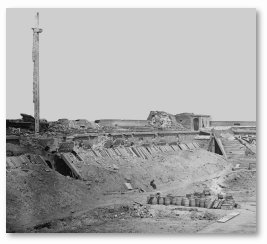|
|
|
MAIN MENU |
| Home |
| Civil War Battles |
|
TIMELINE |
| 1860 |
| 1861 |
| 1862 |
| 1863 |
| 1864 |
| 1865 |
|
VETERANS |
| Honor A Veteran |
| View Veterans |
| Women In The War |
|
MUSIC |
| Union |
| Confederate |
|
UNIFORMS |
| Union |
| Confederate |
|
WEAPONS |
| Union |
| Confederate |
|
CONTACT US |
| Guestbook |
CIVIL WAR BATTLES - Fort Pulaski
|
April 10 & 11, 1862 -
Units:
6th-7th Conn., 3rd R.I., 46th-48th N.Y., 8th Maine, 15th U.S. Infantry, crew of USS Wabash.
Losses:
Union - Union - 1 killed.
Confederacy - 4 wounded, 360 prisoners. |

|
| On April 10, 1862, an artillery barrage began on the last of the great coastal forts built by the United States of America, Fort Pulaski. The stone walls of the edifice were no match for the rifled barrels of a new cannon developed shortly before the War Between the States. It was one of the many technological advancements that would help the North win the Civil War. Batteries lined the northern end of Big Tybee island, the closest slightly more than 1600 yards from the nearest wall of Fort Pulaski, the furthest almost two miles away. The order to commence firing was given and at 8:10am a 13-inch mortar shell from Battery Halleck exploded harmlessly in the air beyond the fort. The second shell, a 13-inch mortar from Battery Stanton, fell in the south channel. At first, while ranging the artillery, the cannon fire was ineffective. Finally, the trajectory was set so that most shells landed in the fort or hit the walls. Hitting the same spot over and over took time and patience but the artillerymen slowly gained accuracy. By the end of the first day Fort Pulaski was in serious danger; the Confederates' ability to return fire had been negated and 2-4 feet of the southeast corner from the parapet to the base now lay in the rocks below. The artillery fire was taking its toll. Inside the fort Colonel Olmstead held out little hope of help from Savannah. Both Fort Pulaski and his command were falling to recent technological advances in artillery. During the night Captain Gillmore kept up occasional fire, if only for the psychological value. Cool morning air greeted the men on either side of the sound on the morning of April 11, 1862. The Norwich, a U.S. gunboat and artillery mounted on a barge in Tybee Creek joined the battle. By noon the walls of Fort Pulaski had been breached in two places and Union forces were preparing to launch an assault. Gillmore, breveted to a brigadier general, ordered the artillery fire to concentrate on the remaining parapets to reduce the Rebel's ability to withstand a direct assault. Now shells were passing through the breach and striking the north magazine where 40,000 pounds of powder were stored. Colonel Olmstead ordered the Confederate flag lowered at 2:30pm, then raised the white flag of surrender. Gillmore demanded an unconditional surrender. Olmstead had no other options. |
